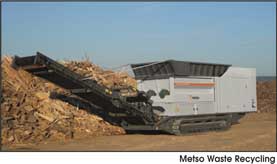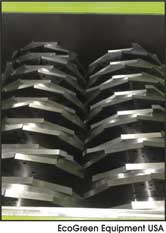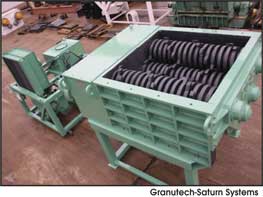by MARY M. COX
Manufacturer List
|
As landfill space continues to come at an ever-increasing premium, the primary reduction of waste, whether involving food, metal, rubber, etc. can help aid in achieving a lean waste end product.
ECO Green Equipment is a leading specialist in the design and manufacturing of industrial grade rubber processing equipment.
“One of our main products is a primary tire shredder called The ECO Green Giant. This machine is a two-shaft primary shredder exclusively engineered for processing whole scrap tires of all sizes,” explained Brad Swenson, managing partner. This machine features a low RPM, high-torque technology that efficiently shreds whole tires into rough rubber shreds, two to eight inches in size, for use or further downstream processing. Production rates for this primary tire shredder are approximately up to 30 metric tons per hour. “This machine is very popular for our clients as it’s the first station in the tire reduction process. From there, processors insert whole tires and can output tire shreds for TDF (tire derived fuel), TDA (tire derived aggregate) and other applications, if desired. To improve performance in the waste reduction process, this shredder includes a patent-pending triangular blade configuration. It provides up to 6 times the life of a traditional shredder blade before sharpening is needed. This drastically reduces wear costs and improves the operator’s bottom line,” Swenson stated.
He cited the primary challenge in volume waste reduction as equipment wear costs. “Operators want to know the cost to purchase, operate, and maintain their reduction equipment. Depending on the desired size of material output, processors want versatility with their equipment. Output size does dictate the amount of processing time, wear, and energy consumption. Accommodating customer needs is sometimes a challenge but despite that, we see a high demand on size reduction for scrap tires, globally. Demand is increasing as many industries seek smaller tire derived aggregate or chips for numerous uses. Industries such as construction, sport, and energy sectors are using tire derived material as a replacement for natural resources used in the past. Many civil engineers and construction companies are looking to primary reduction output from tires for infill and construction material.
“Another industry challenge is OTR mining tire processing. These large industrial tires, used in a variety of mining vehicles, can be extremely difficult and costly to manage. Many mining organizations bury the used tires to dispose of them. ECO Green has a unique procedure and equipment to shred and recycle these large tires,” said Swenson. “We serve all global markets and seek to establish new markets with government, business and organizations that desire to improve their communities and environment,” he concluded.

There are many types and sizes of shredders, well suited for waste reduction and recycling, manufactured by Granutech Saturn Systems. Greg Wright, sales manager advised, “Depending on the application, we will most likely recommend a single, dual, or quad shaft shredder. Choosing one over the other is related to desired throughput, sizing, and material to be shredded. Typical processing volume is between one to five tons per hour, but our equipment can handle much more depending on the material involved and final product size requirements.
Wright noted that challenges vary from one processor to another, depending on the user and industry involved: “For instance, someone who burns waste for fuel will likely face challenges with permits and environmental regulations while someone who processes to recover plastic may be impacted by the price of oil. Low oil prices make plastic processing less cost effective. Striking a balance between through put, final product sizing, ability to handle contaminants, and system price can be a big challenge.”
As the importance of material recovery continues, it becomes necessary to shred the product smaller for better separation, which impacts throughput. “Different levels of waste shredding might range from a coarse shred bound for the landfill, to a finer shred for ferrous metal recovery with a magnet and nonferrous metal recovery via an eddy current separator. Sometimes material is presorted to remove heavy contaminants such as steel pipe, hammers, etc.; other times it is not.
Depending on the requirements, we might recommend one type of shredder over another. We offer shredders with hydraulic, electric, and hybrid drive systems for meeting those various requirements. Providing up to 30 percent higher performance compared to traditional shredder hydraulic drives, our hybrid drive system is ideally suited for waste. It offers a constant horsepower design, allowing for speed and torque variation—for maximum production. Our product line also includes crushers and balers to meet a variety of applications,” stated Wright.
Metso Waste Recycling products include waste shredders, pre-shredders and fine-shredders and their products are used extensively in hazardous waste plants, waste-to-energy plants, MBT plants, landfills, RDF plants and composting plants globally. Both stationary and mobile shredders are available – mobiles, both as track and wheel mounted, and stationary shredders tailored for use in recycling facilities. A wide range of models and configurations (shafts, knives and cutting table sizes) enables a shredder fit for every purpose. Capacities range from 20 to 200 tons per hour.
“The waste handling industry is evolving fast and customers need efficient, reliable equipment that will do the job. Waste streams can vary extensively, challenging all quality parameters of the shredding process. Serviceability is key, and the running cost plays a vital role for waste handlers. Our answer to these challenges is a globally proven, unique design – made to last, providing customers with superior return on investment,” Uffe Hansen, director, waste recycling, said.
He added, “Reducing waste is a tough job. So, excellent service is crucial for waste handlers. This is why Metso offers the strongest network of service hubs and distributors available, to ensure customer care is never far away. Landfill use is still predominant in the U.S. while recycling trends move forward in the US and globally. This calls for intelligent solutions for materials recovery facilities (MRFs). Efficient, continuous and homogeneous shredding is key to optimal sorting later in the cycle.
“Material handling is about getting valuable materials back from the waste stream. Metso has been leading the shredder market for the municipal solid waste market and provides unparalleled solutions in that field.”
Published in the November 2016 Edition of American Recycler News









